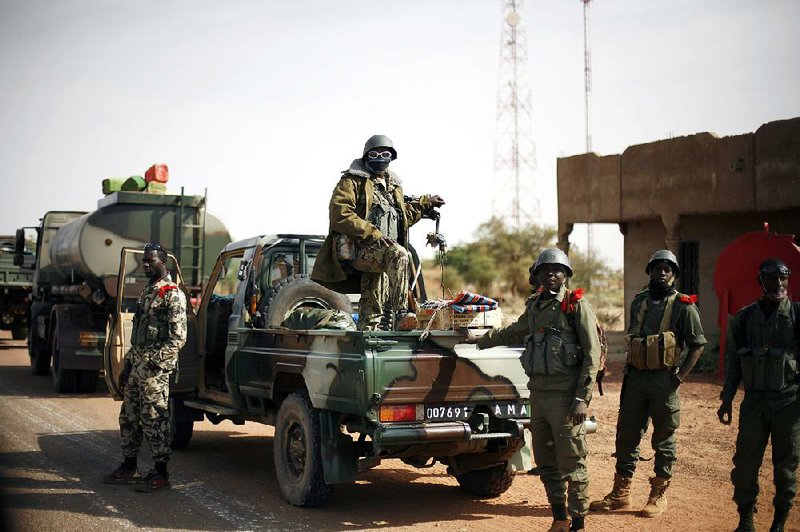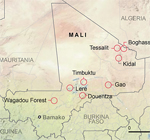KONNA, Mali — French and Malian troops regained control of the airport and bridge of the crucial northern city of Gao on Saturday, marking their biggest advance yet in their bid to oust al-Qaida-linked extremists who have controlled northern Mali for months, military officials said.
The move comes just two weeks after France launched its military offensive in support of the shaky central government of this former French colony. It is unclear what kind of resistance French and Malian troops will face in the coming days.
The French military said in a statement on its website that their special forces, which had stormed in by land and by air, had come under fire from “several terrorist elements” that were later “destroyed.”
In a later news release titled “French and Malian troops liberate Gao,” the French Ministry of Defense said coalition forces were bringing back the town’s mayor, Sadou Diallo, who had fled to Mali’s capital, Bamako.
A city official interviewed by telephone said coalition forces only controlled the airport, the bridge and surrounding neighborhoods.
And in Paris, a Defense Ministry official clarified that the city had not been fully liberated, and that the process of freeing Gao was continuing.
Both officials spoke only on the condition of anonymity because they were not authorized to speak publicly on the matter.
Swooping in under the cover of darkness, the French and Malian forces faced sporadic “acts of harassment” during the day, Col. Thierry Burkhard, a French military spokesman in Paris, said. He had no immediate estimate on casualties.
Gao, the largest city in northern Mali, was seized by a mixture of al-Qaida-linked fighters over nine months ago, and the battle to retake the city is expected to be tough.
The rebel group that turned Gao into a replica of Afghanistan under the Taliban has close ties to Moktar Belmoktar, the Algerian citizen who has long operated in Mali.
The Pentagon said late Saturday that Defense Secretary Leon Panetta has told France that the U.S. will aid the French military with aerial refueling missions.
The U.S. was already helping France by transporting French troops and equipment to the West African nation.
The French assault began with the capture of the airport, a strategic landing strip that opens the way for easier sorties all over northern Mali.
The further capture of a major bridge leading into the town means that the jihadists “saw their means of transport and their logistics sites destroyed,” French Defense Minister Jean-Yves Le Drian said.
The operation in Gao comes at the same time as airstrikes in the two other provincial capitals held by the extremists - the cities of Timbuktu and Kidal, which like Gao fell to the rebels last April, during the chaotic aftermath of a coup in the distant capital. Nearly 30 bombs have been dropped from fighter jets over the past two days, said France’s military in a communique.
The simultaneous aerial attacks come at the same time that ground troops are carrying out a pincer movement, with French and African land forces heading to Gao from Niger, where Chad has sent a battalion.
French and Malian forces are also heading to Timbuktu, via the central corridor that leads straight north from the Central Malian city of Segou.
Since France began its military operation, the Islamists have retreated from three small towns in central Mali: Diabaly, Konna and Douentza.
For the first time on Saturday, Malian authorities opened the town of Konna to reporters. Although in most places Malians have applauded the arrival of the French, the town of Konna, built around a single hard-top road, provides a counterweight and reveals the human toll of the operation.
Konna’s mayor had earlier said that 11 civilians were killed during the airstrikes. Among them were four relatives of Souleymane Maiga, a young,20-something man who ran for cover on Jan. 11, the first day of the airstrikes.
He hid between two mud walls separating his compound from that of his neighbor. His aunt, and the four children, including several young girls that were with her, abandoned a pot on an open flame.
French combat helicopters, looking for rebels, strafed the buildings made of nothing more than mud and straw.
“The women were preparing food right here in the shade of this tree, when we heard the noise made by the aircraft. I ran and threw myself between the two walls over there,” said Maiga. “After it was over, I went to the house, and when I opened the door, I saw that they were dead. Of the five people inside, only one survived. A toddler.The bodies were one on top of the other. The toddler was crying. The bullets had pierced the door. I tried to find their pulses, but they were gone. I realized it was over. I picked up the child and took him to a relative’s house in town.”
The zinc door of the modest house is pockmarked by bullet holes, some several inches wide.
Information for this article was contributed by Jamey Keaten and Baba Ahmed of The Associated Press.
Front Section, Pages 6 on 01/27/2013


